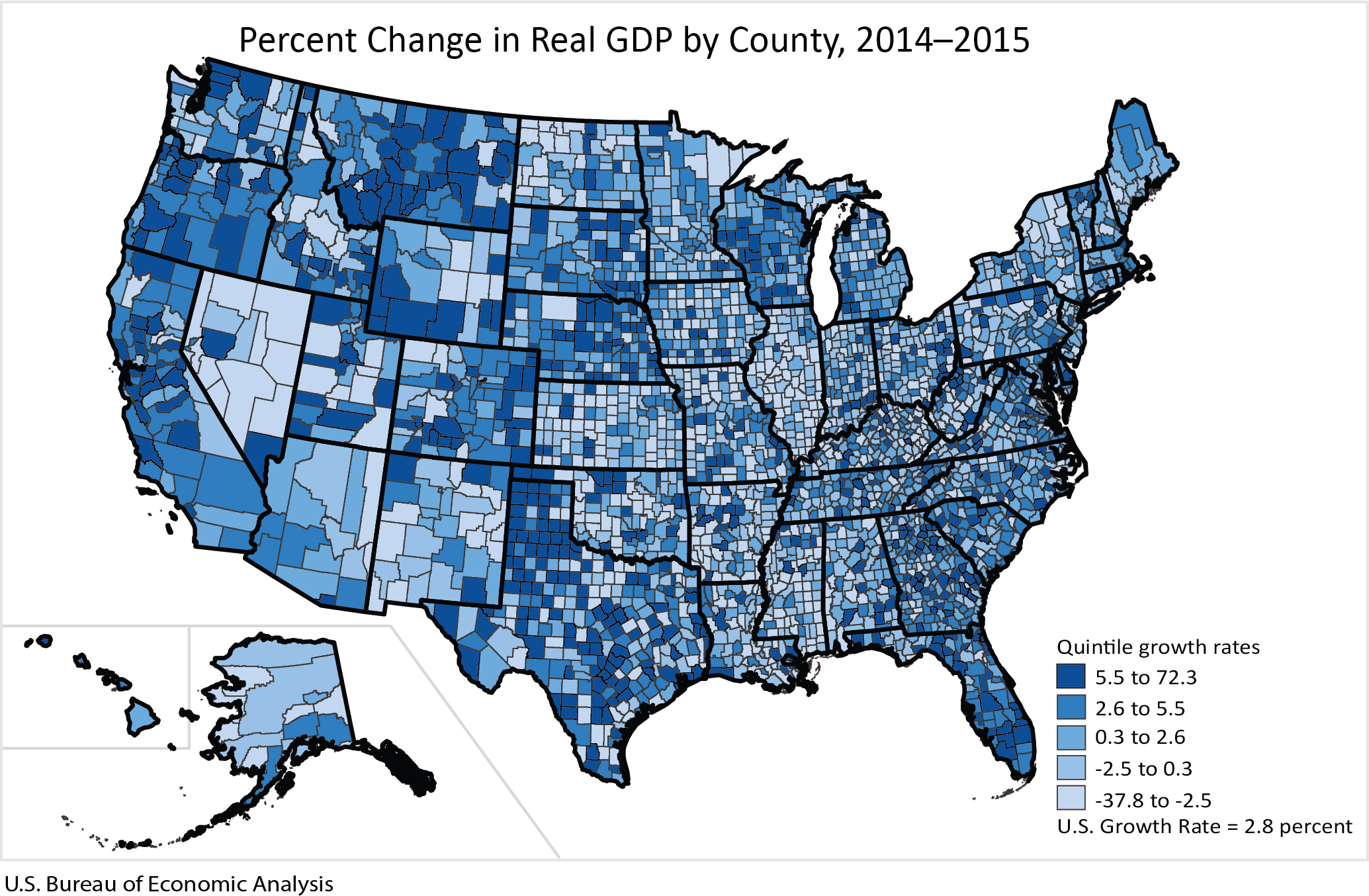News Release
Prototype Gross Domestic Product by County, 2012-2015
Today, the Bureau of Economic Analysis released prototype statistics for gross domestic product (GDP) by county for 2012-2015. Combined with BEA's county estimates of personal income, GDP by county offers a more complete picture of local area economic conditions. In conjunction with their release, BEA is requesting feedback and comments on these prototype statistics to assist in improving their quality, reliability and usefulness.
"This is the first time the Bureau of Economic Analysis is providing GDP statistics for each and every county in the United States," said Secretary of Commerce Wilbur Ross. "The prototype data addresses one of the last remaining gaps in economic knowledge, offering policymakers and businesses a new tool to inform their decision-making."
These prototype GDP statistics, which provide detail for 3,113 counties, include industry breakouts for private goods-producing industries, private services-producing industries, and the government and government enterprises industry group. These statistics represent another step forward in meeting BEA's long-standing goal of providing a more detailed geographic distribution of the nation's economic activity. County-level GDP statistics will assist analysts in the assessment of local economic performance and policymakers in the development of strategies to promote economic growth. They will also help answer important questions related to the size and condition of local area economies, industrial composition, and comparative growth trends.
GDP by county statistics provide a richer picture not only of the distribution of national economic output, but also of national economic trends and their manifestation at finer and alternative levels of geographic detail. They can be used to inform resource allocation decisions and support economic development strategies that target areas with the greatest need by identifying strengths and weaknesses of local economies. GDP by county statistics can also support research into understanding local economic dynamics, the longer-term impacts of different development strategies, and the effectiveness of incentive programs used to support these strategies.
Highlights
In 2015, real (inflation adjusted) GDP increased in 1,931 counties, decreased in 1,159, and was unchanged in 23. Real GDP ranged from $4.6 million in Loving County, TX to $656.0 billion in Los Angeles County, CA.
Large County Highlights
- Of the 138 large counties, those with populations greater than 500,000, real GDP increased in 125 and decreased in 13 in 2015.
- Real GDP ranged from $13.9 billion in Volusia County, FL to $656.0 billion dollars in Los Angeles County, CA.
- Denton County, TX (12.2 percent) and Santa Clara County, CA (11.1 percent) had the largest increases in real GDP in 2015. Growth in both counties was led by increases in private services-producing industries.
- The largest decreases in real GDP in 2015 were in Marion County, IN (-4.2 percent) and Montgomery County, TX (-2.3 percent). The private goods-producing industries led declines in both counties.
Medium County Highlights
- Of the 461 medium-sized counties, those with populations between 100,000 and 500,000, real GDP increased in 336, decreased in 120, and was unchanged in 5 in 2015.
- Real GDP ranged from $1.7 billion in Flagler County, FL to $52.3 billion dollars in Morris County, NJ.
- Whatcom County, WA (26.9 percent) and Guadalupe County, TX (22.0 percent) had the largest increases in real GDP in 2015. Growth in Whatcom County, WA was led by increases in private services-producing industries, while growth in Guadalupe County, TX was led by increases in private goods-producing industries.
- The largest decreases in real GDP in 2015 were in Waukesha County, WI (-16.1 percent) and Tazewell County, IL (-13.4 percent). The private services-producing industries led declines in Waukesha County, WI, while private goods-producing industries led declines in Tazewell County, IL.
Small County Highlights
- Of the 2,514 small counties, those with populations less than 100,000, real GDP increased in 1,470, decreased in 1,026, and was unchanged in 18 in 2015.
- Real GDP ranged from $4.6 million in Loving County, TX to $8.7 billion dollars in St. Charles Parish, LA.
- Roberts County, TX (72.3 percent) and Briscoe County, TX (68.4 percent) had the largest increases in real GDP in 2015. Growth in both counties was led by increases in private services-producing industries.
- The largest decreases in real GDP in 2015 were in Slope County, ND (-37.8 percent) and Sanders County, MT (-34.9 percent). The private goods-producing industries led declines in Slope County, ND, while private services-producing industries led declines in Sanders County, MT.
Next Steps
The public is invited to submit comments and feedback by emailing gdpbycounty@bea.gov. Data users' evaluations and comments will be used to help review and finalize data sources and the methodology used in preparing these statistics. Official GDP by county statistics are scheduled for release on December 12, 2019.
Additional information on the GDP by county statistics, data sources, and methodology will be available in the January 2019 issue of the Survey of Current Business.
Next release: December 12, 2019 – Local Area Gross Domestic Product, 2018
